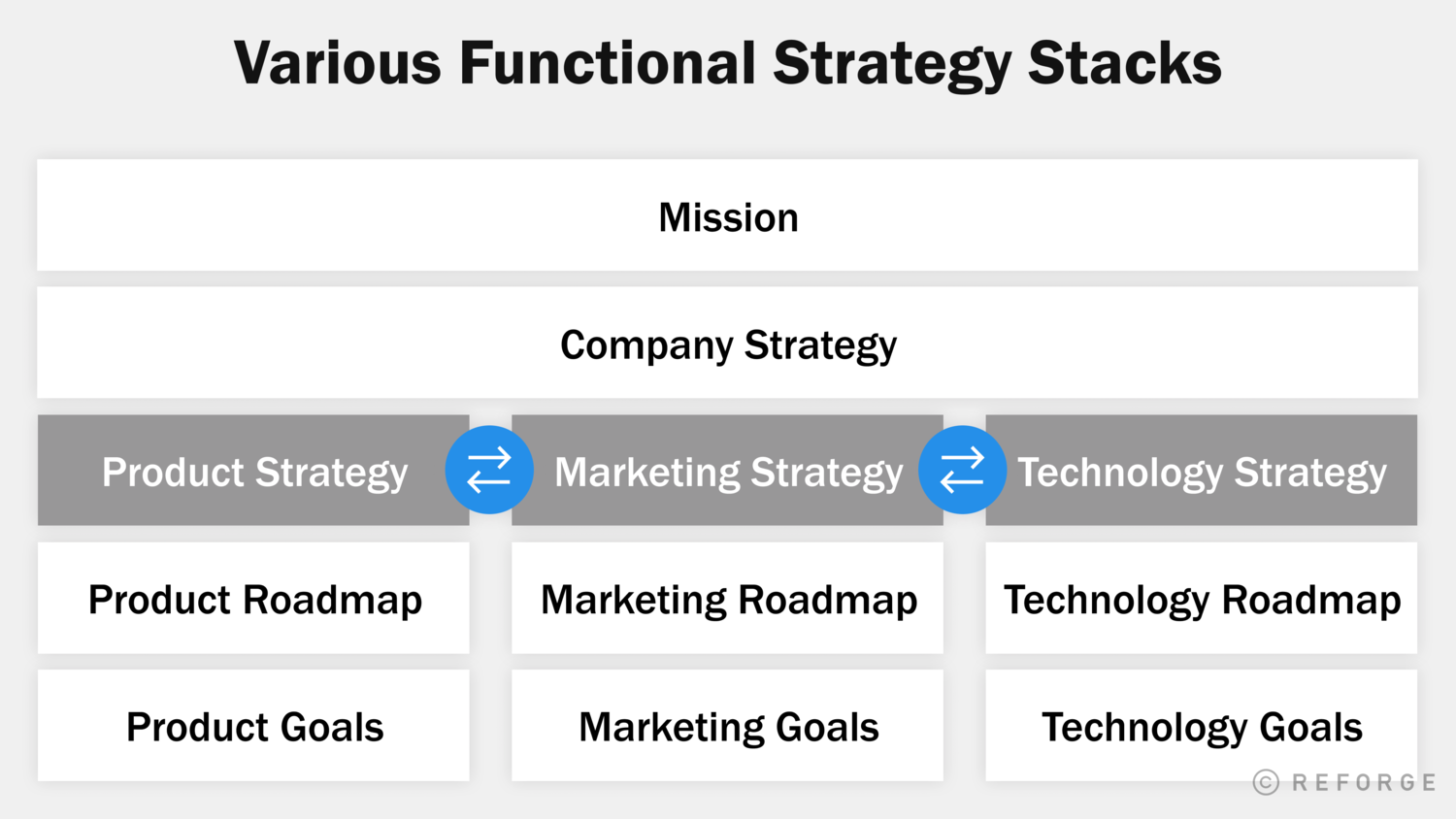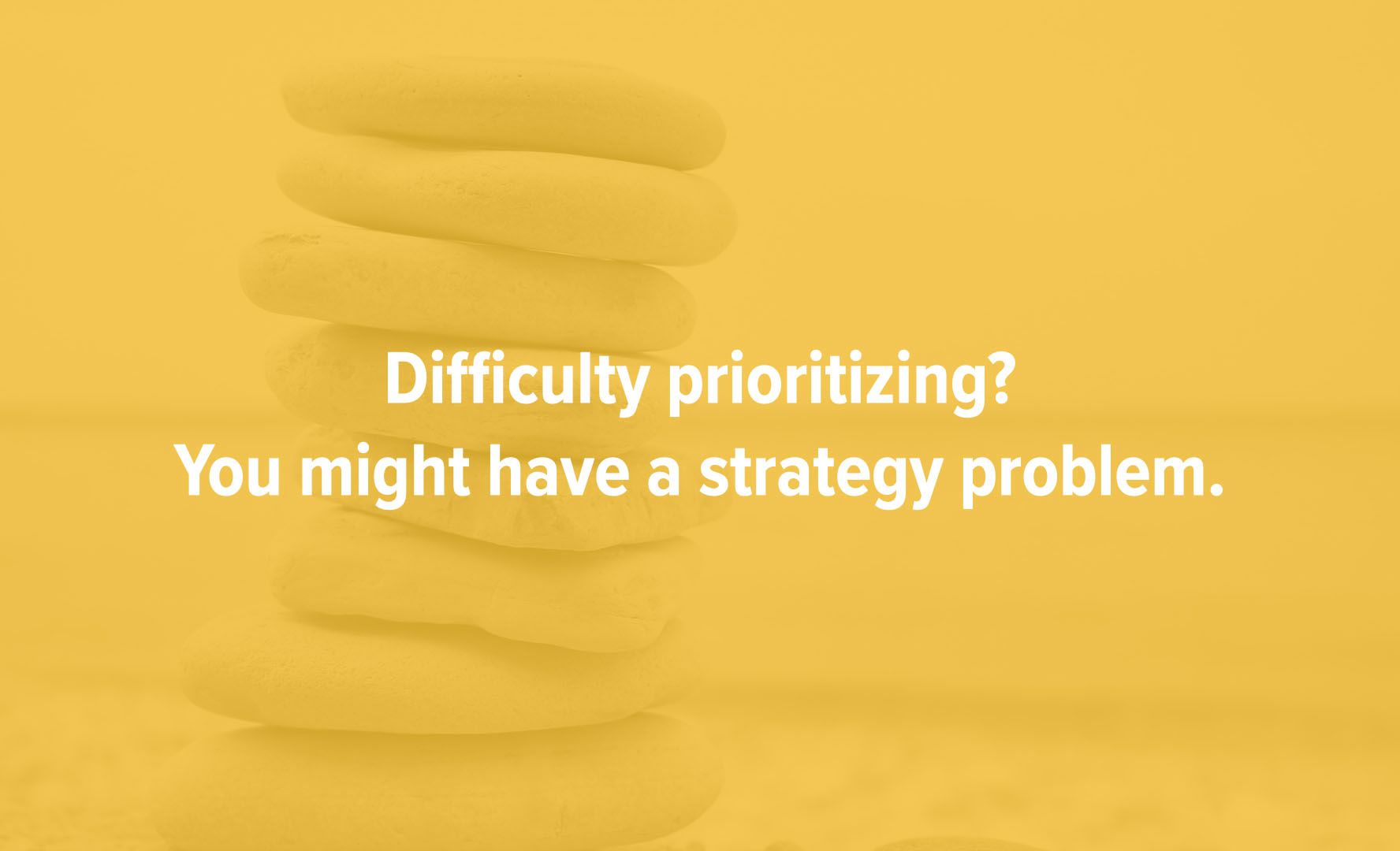This article was originally published on Reforge.
As software has eaten the world, product has become the most important lever for a company's success. In the past, companies gained a strategic advantage by excelling in supply chains, logistics, manufacturing, and other operational capabilities. Today, companies win or lose based on the quality of their products—and this puts enormous pressure on product teams to not just deliver products, but deliver products that drive the company's strategy.
But strategy is often misunderstood. The word "strategy" has been stretched to a point where it is almost devoid of meaning. Too often, the terms "vision," "mission," "strategy," "goals," and "roadmap" get conflated into a jumbled mess—leaving product leaders without the context they need to focus their work on the difficult task of moving the company forward.
Sometimes, this lack of clarity is apparent. Product teams may know that they don't have a clear enough understanding of the strategy. More often, the lack of clarity manifests in hard to diagnose ways. For example, product teams may struggle to answer prioritization questions:
- Should I prioritize building a new feature or optimizing an existing flow?
- Should I prioritize closing more deals or extending existing contracts?
- Should I prioritize building this tool in-house or license a third party service for now?
In answering these questions, product leaders may think to themselves: "prioritization is hard," "these tradeoffs are impossible to make," and "I don't feel confident in this prioritization." In many cases, the difficulty prioritizing these low-level execution questions is due to a more high-level problem.
Difficulty prioritizing is often a strategy issue, not an execution issue. It is impossible to make rigorous prioritization decisions when the guidance on how to do so is missing, unclear or disconnected from what you are trying to do.
This problem not only affects prioritization but also manifests in other hard to diagnose ways: muddied UX, miscommunication within teams, lack of coordination across teams, diminishing returns, product-market fit saturation, and negative impact on team morale. In many cases, these execution issues are the symptom of gaps in strategic thinking.
Gaps in strategy make it harder for teams to execute. This results in loss of opportunities. Execution becomes much easier when the strategy is clearly defined, communicated and connected to the company's mission and its day-to-day work.
What is the Product Strategy Stack?
In order to diagnose and fix these issues, we need to be able to track the issues back to the source. To do this, we can't think about "strategy" as some amorphous, all-encompassing concept. Instead, companies should think about the relationship between mission, strategy, roadmap, and goals as a stack of distinct concepts:
- Company Mission - The world your company sees and the change it wants to bring to that world.
- Company Strategy - The logical plan you have to bring your company’s mission into being.
- Product Strategy - The logical plan for how the product will drive its part of the company strategy.
- Product Roadmap - The sequence of features that implement the Product Strategy.
- Product Goals - The quarterly and day-to-day outcomes of the Product Roadmap that measure progress against the Product Strategy.
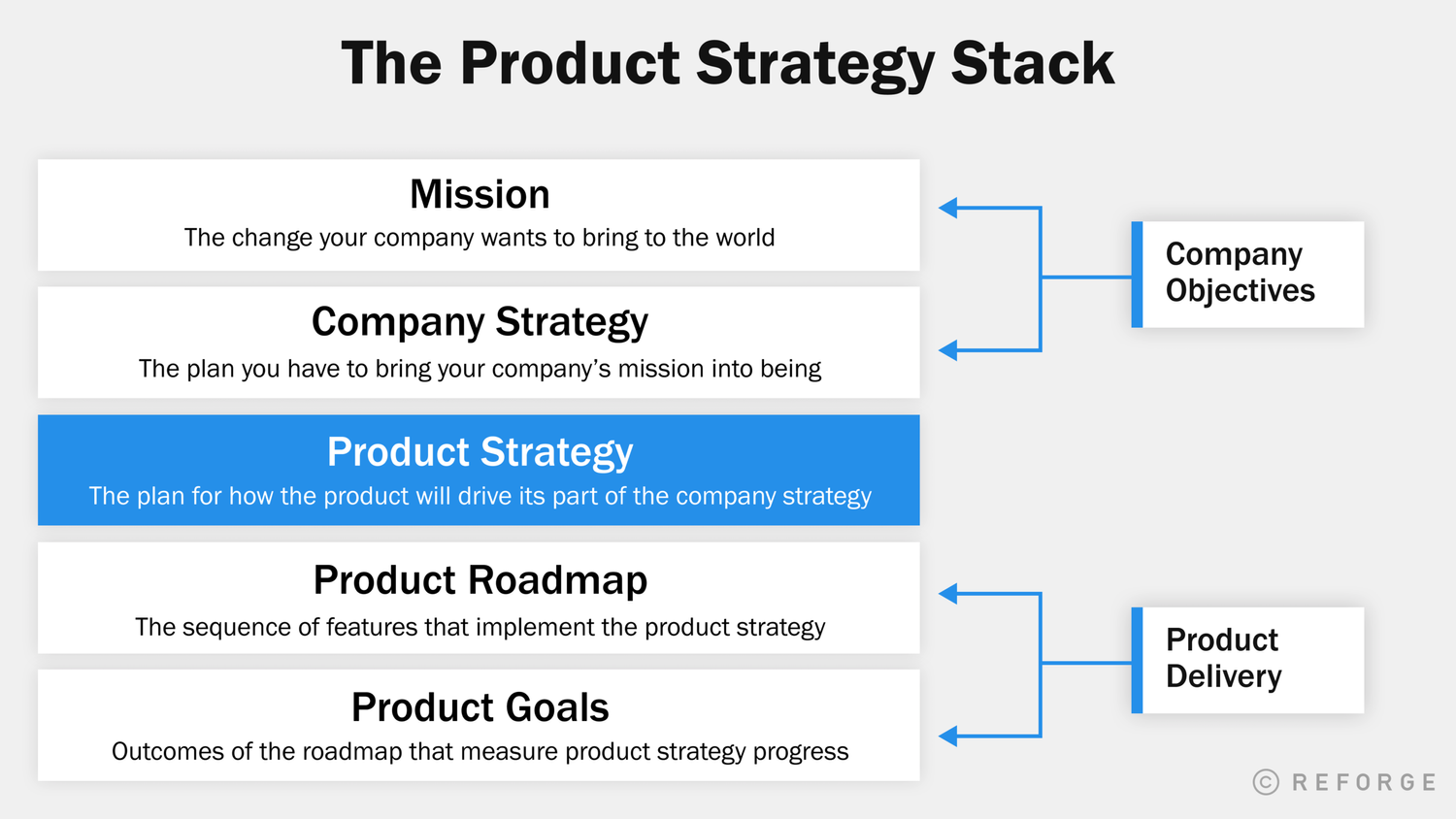
Product Strategy is the Connective Tissue
Importantly, each layer of the stack builds on the previous layer. Put another way, each layer is a prerequisite for the successive layer. We cannot have a company strategy without knowing our company's mission. We cannot have product goals without knowing our product strategy. Given this relationship between the layers, Product Strategy serves a critical role—it is the connective tissue between the objectives of the company and the product delivery work of the product team.
Tops Down = Definition, Bottoms Up = Evaluation
The Product Strategy Stack is a system we can use for both planning and execution:
Tops Down
Teams can work from the top of the stack down to 1) define the stack, 2) work at a progressively finer level to plan product execution, and 3) align the company to that execution plan.
Bottoms-Up
In addition, teams can work bottoms-up to 1) communicate the status of execution and 2) track how well the product team's work is driving company-level objectives.
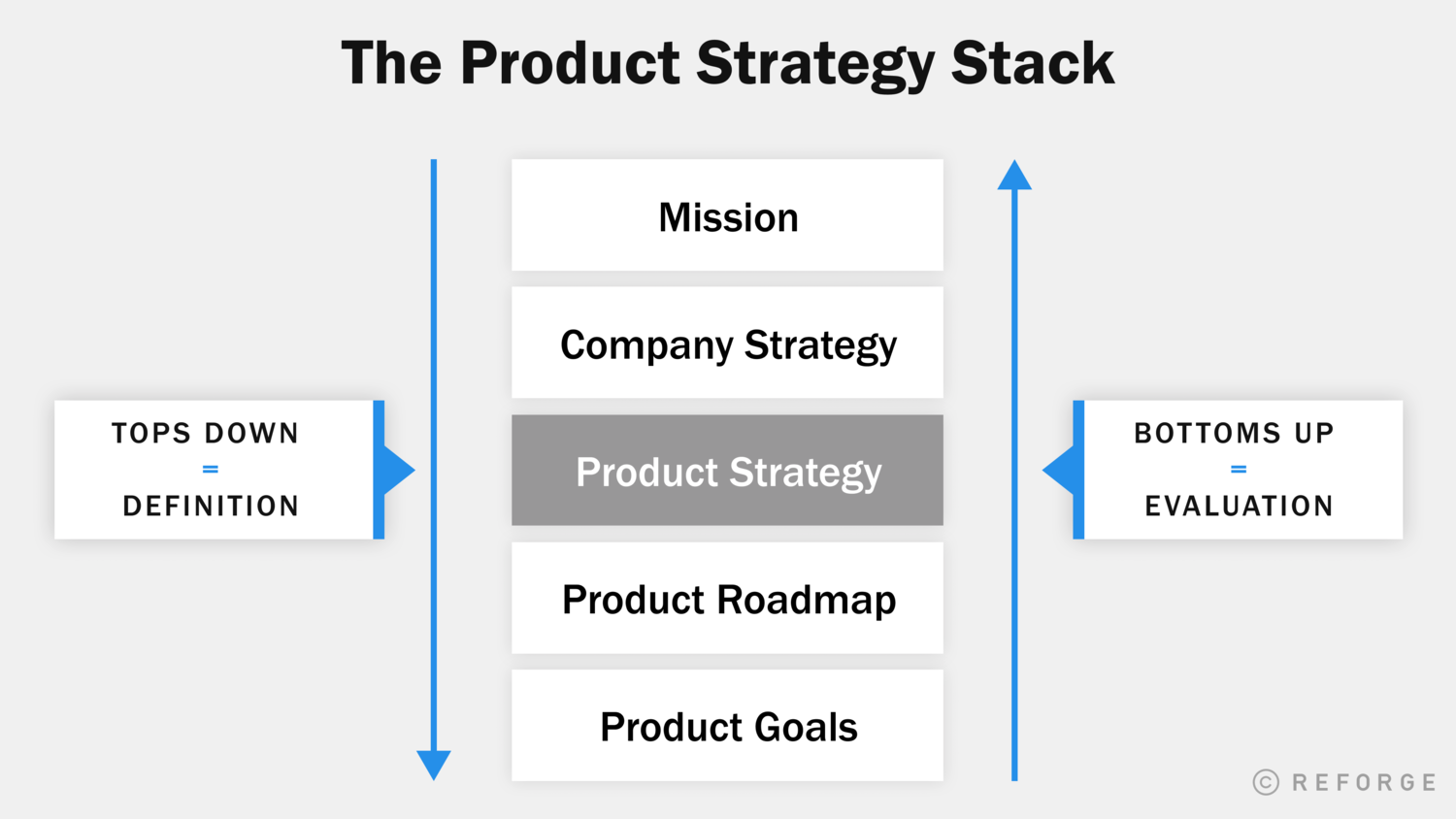
Slack vs. Discord: A Case Study
Before we take a closer look at the stack, let's look at an example by comparing the stacks of two different companies: Slack, the workplace productivity platform, and Discord, the messaging platform designed for gamers.
Different Missions
The missions for Slack and Discord are entirely different. Fundamentally, Slack is for work and Discord is for play. Slack's mission is to make people's working lives simpler, more pleasant, and more productive. Discord's mission is to give people the power to create belonging in their lives.
Different Company Strategies
These different missions fuel different strategies. Slack's strategy focuses on improving workplace productivity and Discord's strategy focuses on building communities, initially with a focus on gamer communities.
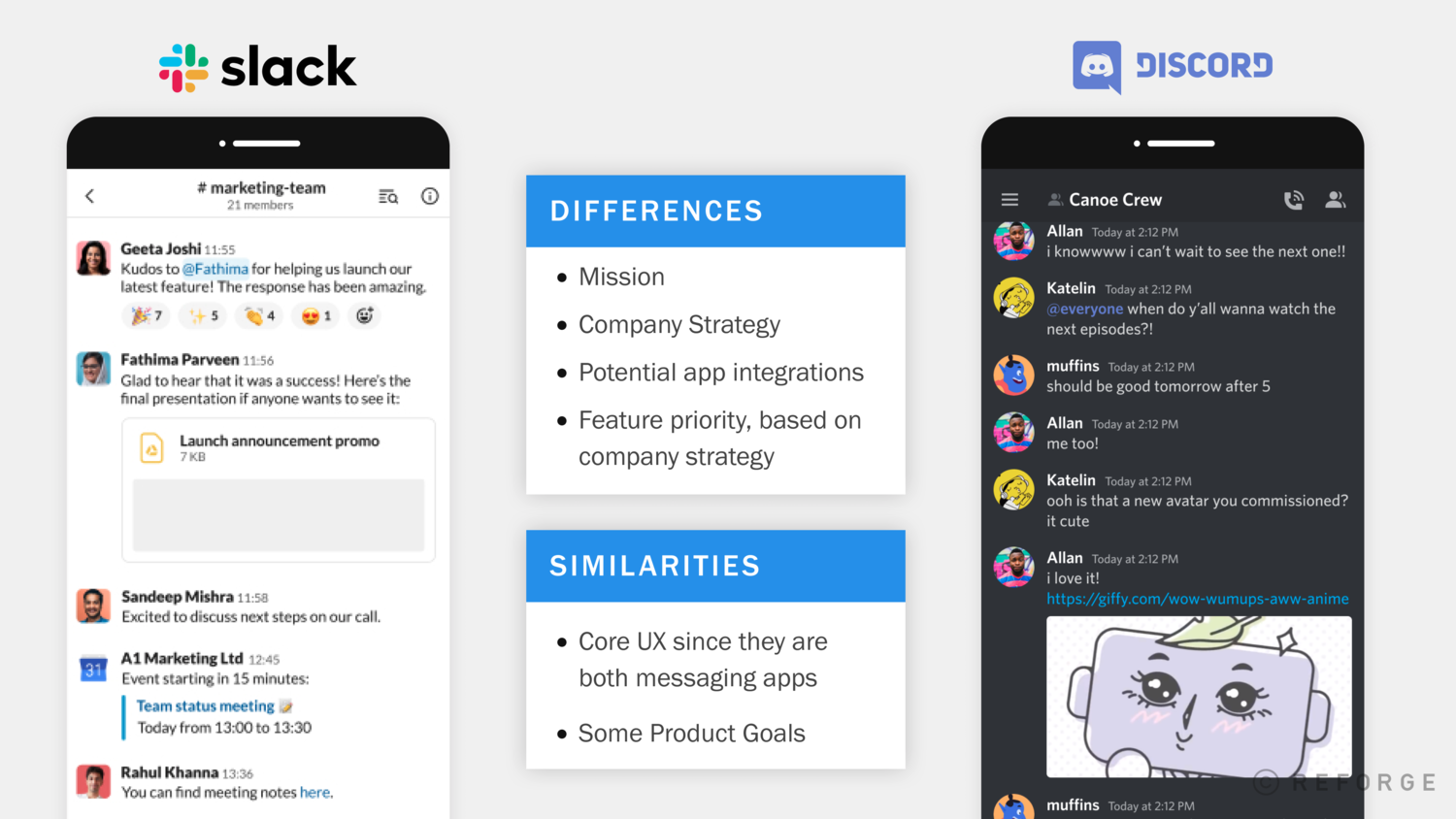
Similar Product Strategies
However, once we get into the product, things begin to look more similar. The user experience for both products is surprisingly alike. A casual observer might mistake the apps for each other, if it were not for the different color schemes. The desktop clients for Slack and Discord use nearly identical multi-column layouts, with UI to select a particular space, select a channel within that space, and a chat window for that channel.
Although the mission and strategy for Slack and Discord are entirely different, there is significant overlap in the work their product teams have done. A PM at Slack and a PM at Discord might be working towards the same product goal, but in service of entirely different company strategies. Therefore, it is critical for roadmaps and goals to be tethered to product and company strategy rather than defined in isolation.
In certain cases, this may mean that PMs at Slack and Discord arrive at the same answer. For example, both products have the ability to react to a chat message with an emoji. Since both products have a social element to their mission, it's important to provide a lightweight way for people to react to each other within the chat.
In other cases, the Slack and Discord products will diverge to better align with the companies respective missions and strategies. For example, the products have a different emphasis for their 3rd party integrations.
Since Discord focuses on community building, it prioritizes features that will help its users feel a sense of community, such as integrating with Spotify so you can see what kind of music your friends enjoy. Since Slack focuses on productivity, it prioritizes features that will help its users become more productive, such as integration with JIRA so its users can easily file tasks based on a Slack discussion. Without a clear strategy, product leaders at Slack and Discord would not know which features to prioritize.
The Product Strategy Stack helps us solve one of the biggest reasons for startup failure—ambitious goals that are untethered to a clear strategy. Slack and Discord have been able to succeed in very different markets—not because of very different products, but because each aligned its product strategy, roadmaps, and goals to a well-defined company-level mission & strategy.
What Problems Does the Product Strategy Stack Solve?
Before we take a closer look at each layer of the Product Strategy Stack, let's look at the problems the stack is designed to solve. There are four common traps teams fall into when defining product strategy.
Misconception #1: Goals = Strategy
💡 The Product Strategy Stack defines a clear distinction and relationship between goals and strategy.
Goals are often conflated with strategy. Neither of these terms share a universal definition within the industry, nor do companies take time to ensure that the understanding of these terms is universal within their org. Strategy is the plan to achieve your goal—not the goal itself. Your strategy tells the team how they will win. The goals tell your team what winning looks like. For example, a chess player will have a detailed set of plans (i.e., the strategy) to win a match (i.e, the goal).
A company might mistakenly say "our strategy is to increase revenue by 20%." Increasing revenue is a goal, not a strategy. There could be multiple ways to increase revenue—such as entering a new market segment or doubling down on converting freemium to paid customers. How should the goal be achieved? This how is the strategy, which is not always clearly defined. Instead, companies should define both the goal and the strategy: "Our strategy is to increase revenue by 20% by expanding into two underserved markets, Mexico and Brazil."
Misconception #2: Achieving Goals = Achieving Strategy
💡 The Product Strategy Stack provides a tool to help teams track how well product team's work is driving company-level objectives.
Companies want to put in place the right incentives to reward employees for adding value. However, it's much easier to evaluate whether or not a goal was achieved than to evaluate whether or not a strategy was achieved. Teams are thus incentivized to prioritize goals that are often short-term.
However, achieving goals does not necessarily mean that a company has made progress on its strategy. Goals may have been defined in isolation or based on incorrect assumptions. In addition, strategy is subject to external factors, such as competitive moves and market conditions. Companies must be vigilant about understanding strategic progress beyond achieving short-term goals. If companies lose sight of that strategic progress, then they will eventually get disrupted over the long term.
Kodak invested in Ofoto, a photo sharing app in 2001, before Facebook existed. Ofoto was going to help Kodak expand their print business by making it easy for their customers to print digital images. Kodak achieved the goals they set for Ofoto, but they failed to achieve a digital photo sharing strategy. Kodak missed the opportunity for digital photography to become their new business, and filed for bankruptcy a few years down the road.
Misconception #3: Product Strategy = Company Strategy
💡 The Product Strategy Stack clarifies the relationship between company strategy and product strategy.
A common mistake is for product leaders to assume that product strategy is the same as company strategy. In doing so, they under-appreciate the role that sales, marketing, support, and other functions play in company success. Product has become more central to strategy as logistics/operations have been commoditized, but product is not the exclusive driver. By focusing on aligning other functional strategies with product, companies can better position themselves to win in the market.
From the outside, Stitch Fix may seem like a styling app that better understands your styling preferences over time and uses this knowledge to deliver the right set of clothes to you. However, in order to be a be profitable business, Stitch Fix needed not just a great interface that was easy to use and delivered a great match, but also a great operations strategy that would bring operational costs down. Stitch Fix heavily invested in data science to optimize their clothing inventory and logistics management. This helped them better predict how much inventory to purchase and how to move it out of the warehouse faster—product strategy and operational strategy worked together to deliver a valuable and hard-to-replicate offering.
Misconception #4: Goal → Roadmap
💡 The Product Strategy Stack defines the Product Roadmap as a prerequisite to Product Goals.
Many companies believe that teams should set goals first, then define the roadmap to meet those goals. The thinking goes something like this: As a company, we know what we want to accomplish (i.e, the goals) and we'll empower our teams to figure out how to do it. However, this rarely works in practice. In the absence of any roadmap, teams are rudderless. This "goals first" approach incentivizes teams to do whatever it takes to achieve short-term goals, often at the expense of a focused feature set, clear UX, and long-term progress towards the strategy.
Instead, goals should flow from a product roadmap that has been designed to deliver value to users. As a result, product teams are empowered to move away from "seeing what sticks" to a customer-centric approach to product development.
Stripe has rapidly expanded its offerings from its core payment product to a set of related products and services, each reinforcing its strategy. These offerings include Stripe Atlas (a service to help startups incorporate) and Stripe Press (a publisher of books about economics and technological advancement). A "goals first" approach would have encouraged product leaders to focus on the short-term task of optimizing payment adoption and conversion, not the strategic task of expanding offerings into initiatives that may take years to pay off. By helping online businesses set up faster, and sharing ideas which help build better businesses, Stripe is better positioned to bring more businesses online and turn them into Stripe adopters. This drives Stripe's mission to "increase the GDP of the Internet".
The Product Strategy Stack in Depth
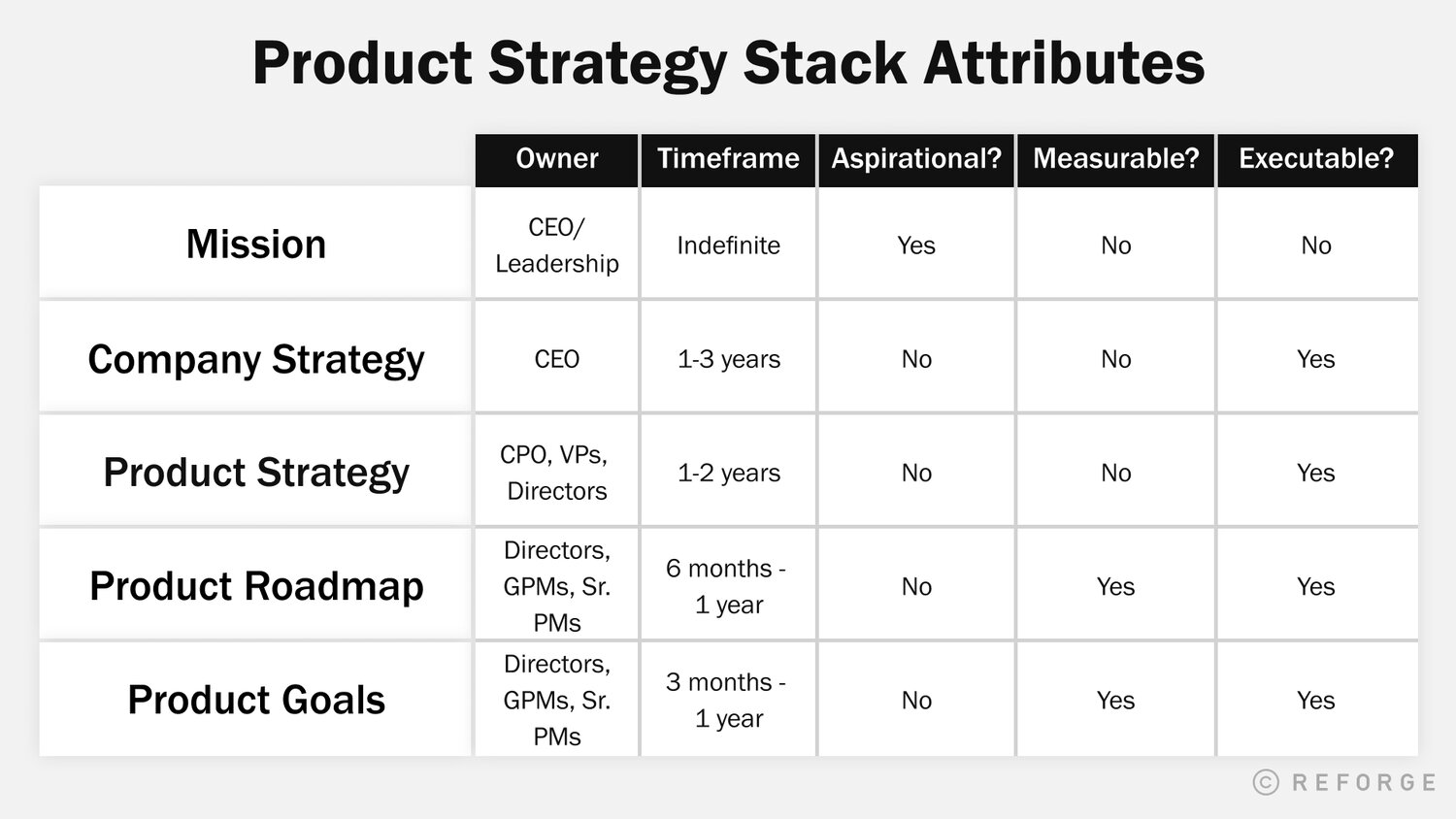
Company Mission
The world your company sees and the change it wants to bring to that world.
Company Mission is at the top of a Strategy Stack. The Company Mission defines the company's purpose. A good Company Mission is aspirational and has emotional appeal—it motivates your team to come to work every day and your customers to embrace the role your company plays in their lives.
Great companies are mission-driven and seek to align strategic initiatives to their mission. For example, Google's mission to "organize the world's information and make it universally accessible and useful" is manifest in its products such as Google Search, Maps, Android, and Gmail.
Company Mission is the most durable layer of the stack—typically lasting for years before it is outdated. Your Company Mission shouldn't be limited by execution considerations. Often, a Company's Mission is aspirational beyond its scale (some 10 person companies have as grand a mission as a 10,000 person company). Your Company Mission should only change as the company's view of the world changes (sometimes because the company has made its dent in the universe!). This typically happens over the course of years, whereas the rest of the strategy stack changes on a monthly/quarterly/annual basis.
Some companies define both a vision and a mission. In this case, "vision" is a description of the world your company sees, and "mission" is the role your company plays in that world. For simplicity, we can think about vision and mission as a single layer in the stack. The vision and mission work hand-in-hand to paint an aspirational picture of what your company is designed to accomplish.
In 2017, Facebook changed its mission (established in 2010) from "Making the world more open and connected" to "Give people the power to build community and bring the world closer together." In a letter Mark Zuckerberg published, he acknowledged the shortcomings of the earlier mission statement. With a pivot in their mission, Facebook made more strategic investments in building infrastructure and tooling for users to create and engage with communities.
Company Strategy
The logical plan you have to bring your company’s mission into being.
The next layer in the stack is Company Strategy. Your company strategy flows from your mission. It defines the plan by which your company will achieve its mission and and generate value from that mission. Often, companies think about strategy in quantitative terms (our strategy is to achieve a CAGR of 20% over the next 3 years). However, this conflates strategy (the plan) with goals (the measure of progress).
Instead, strategy should be rigorously logical. It clearly defines the sequence of steps your company needs to take, and it should account for the company's position in the market, unique strengths, and the set of situational risks/assumptions that factor into the plan. Importantly, strategy must be defined granularly enough to be executable—it must provide enough context for teams to be able to define effective roadmaps and goals.
As we saw with Slack vs. Discord, Company Strategy plays an important part in defining what makes a company successful. Get this right—because a well-defined strategy empowers and aligns the entire company.
Company Strategy changes more often than Company Mission. Typically, a well-defined strategy will last 1-3 years, and companies should re-assess their company-level strategy once a year.
Example: Quora's mission is to share and grow the world's knowledge. Google's mission is to organize the world's information and make it universally accessible and useful. Both companies have similar missions, but operate out of completely different company strategies. Google's strategy involves indexing the Internet to provide easy access to knowledge when a user searches for it. Quora's strategy involves accessing knowledge in a structured question-and-answer format.
Product Strategy
The logical plan for how the product will drive its part of the company strategy.
The next layer of the Product Strategy Stack is its namesake. Product Strategy serves an important role in the stack—it is the connective tissue between the objectives of the company (its mission and its strategy) and the work of the product team (product roadmap and goals). Like Company Strategy, Product Strategy is a rigorously logical and executable plan. The Product Strategy defines how the product will drive the company's strategy and enable the company to achieve its mission. As a result, an effective product strategy cannot exist without a clear understanding of what the company seeks to achieve. An effective product strategy cannot exist in isolation.
Product Strategy changes at the same pace (or slightly more often) as Company Strategy. Typically, a well-defined product strategy will last 1-2 years, and companies should re-assess their product strategy once a year.
Quibi and TikTok had similar missions and strategies. Both companies sought to provide bite-sized entertainment uniquely well-tailored to mobile. But, the two companies implemented completely different product strategies. Quibi's product strategy was to enable Hollywood's top creators to bring their craft to mobile devices, and TikTok's product strategy is to enable its own users to create and share snackable content. Quibi's product strategy failed to capitalize on the social nature of mobile devices and the rising importance of the creator economy.
Product Roadmap
How you sequence product strategy over time.
Once a team has defined a clear Product Strategy, the team is ready to plan out how that product strategy will be implemented over time. The result is a Product Roadmap that guides the team in sequencing its efforts. Proper sequencing is critical to success. As we discuss in the Product Strategy program, sequencing enables product teams to unlock compounding value by prioritizing the learning and product outcomes that will have a disproportionate downstream impact.
The Product Roadmap should come before the Product Goals. The Product Roadmap provides a thoughtful, proactive framework that product teams can use to organize their work. A well-defined Product Roadmap helps teams focus on the important task of long-term value creation for customers. In contrast, product teams operating without a roadmap (or tasked with developing a roadmap in response to goals) will be tempted to achieve goals by any means necessary—resulting in a product that is inconsistent, over-optimized, and caters to the short-term needs of the company.
Product Roadmaps tend to be defined on a 6 month to 1 year time horizon. They play an important role in quarterly goal setting and should be revisited every quarter.
Netflix - By 2007, Netflix observed a rapid decline in the DVD market. Instead of investing in improving DVD rental sales, Netflix pivoted to provide a streaming service "Watch Now." By doing this, Netflix replaced their DVD rental strategy with a streaming strategy and fundamentally changed its roadmap. Their roadmap defined an important sequence. Netflix launched its streaming service by working with partners to deliver an initial catalog of 1,000 shows and movies in 2007. It wasn't until 2013 that Netflix launched its first Originals and pivoted from a streaming aggregator to an original content producer.
Product Goals
The outcomes that measure strategic progress.
The final layer of the Product Strategy Stack is Product Goals. The stack is a system that enables product teams to translate an aspirational company mission into effective product goals, with Product Strategy acting as the connective tissue between those concepts.
Product Goals are set within the context of the Product Roadmap and Product Strategy. They are not valuable in and of themselves, but as a measure of progress towards a pre-determined plan that generates value for the customer.
A good Product Goal is objectively measurable. Most often, a goal is defined as an impact to a quantifiable metric—such as "increase first day return rate by 5%". However, this doesn't need to be the case. Sometimes, the best way to measure progress is to set goals for deliverables—such as "launch new onboarding flow by March 5th." Teams should set goals that reflect their understanding of strategic levers. If a team does not know how to move a metric, then they should not commit to moving that metric. Instead, they should commit to product work that increases their level of understanding.
Product Goals are typically set quarterly and tracked on weekly or daily basis. Teams should revisit Product Goals at least once a quarter to both measure achievement of the goal and assess whether that goal has led to strategic progress. Sometimes, missing a goal means that something needs to change upstream from the goal—often the Product Roadmap or Product Strategy. Other times, missing a goal simply means that the goal was defined incorrectly. In this case, the Product Roadmap and Product Strategy stay the same, but the team should redefine the goal to better measure strategic progress.
In 2013, Tripadvisor added Instant Booking to the product. Up until that point, Tripadvisor had helped travelers pick a hotel based on the opinions of hundreds of millions of travelers, but travelers needed to leave the product to book those hotels. At the time, one study found that Tripadvisor influenced more than 60% of hotel bookings—bookings happening outside of Tripadvisor's product (primarily through online travel agents and hotels that advertised their prices on Tripadvisor).
The Product Strategy for Instant Booking was clear: make travelers' lives easier by giving them the option to shop and book directly on Tripadvisor. But, the product team struggled to make Instant Booking successful. The problem was that the team's Product Goal was not updated to match the team's new Product Strategy. The team was tasked with maintaining or increasing average revenue per traveler, and Tripadvisor's price advertising business continued to be very good. As a result, the product team faced a contentious decision: optimize Instant Booking at the expense of revenue or maximize revenue at the expense of strategy. In this case, the team achieved its Product Goal but did not make enough progress towards its Product Strategy.
Getting Your Product Strategy Stack Right
The Product Strategy Stack is a powerful tool to help you connect your product team's work with company objectives. However, it can be difficult to diagnose strategy problems. Often, these problems surface as low-level execution issues. In these cases, it's helpful to use the layers of the Product Strategy Stack to work backwards towards the root cause.
Let's look at the symptoms of a poor strategy stack, common strategy gaps that many companies face, and an example of a well-defined and well-executed strategy stack.
What does a poor Product Strategy Stack feel like?
Difficulty prioritizing
The most common symptom of a poor strategy stack is difficulty prioritizing. For example, a team may struggle to evaluate the trade-off between optimizing a flow for new users vs. catering to the needs of power users.
Miscommunication within teams
Difficulty prioritizing often leads to a break-down of communication within teams. Some teammates will want to go one way, and others will disagree. Without proper context, people will rely on their individual opinion, rather than align to a shared purpose.
Muddied UX
The lack of clear priorities can take its toll on the user experience. A clear strategy leads to a simple UX. When the strategy is not clear, the team may make inconsistent or compromised choices. Over time, this can have a disastrous impact. The history of tech is littered with bloated products that got disrupted by more opinionated and streamlined upstarts.
Lack of coordination across teams
Without a clear overarching strategy driving roadmaps, teams across a company can get easily misaligned and prioritize different things. This is especially true when teams prioritize different outcomes which make sense locally for their group but do not move the company forward. For example, an enterprise sales team may implement a complicated feature for a single customer, while the core product team is focused on streamlining the product to better support SMBs.
Diminishing returns
In the absence of strategy, teams tend to focus on short-term optimization of metrics rather than long-term value creation. In time, teams over-optimize. They reach a "local maximum" and hit diminishing returns on their efforts. Each "win" is less impactful and harder to reach.
Product-market fit saturation
Eventually, companies hit the limits of their product-market fit when strategy is poorly or incompletely defined. Teams cannot improvise their way to new sources of product-market fit. Instead, product leaders need to anticipate saturation and proactively expand their product market fit to reach new audiences and/or new value.
Negative impact on morale
Over time, a poorly defined strategy weighs heavily on a strong team. The lack of clarity makes a team's work burdensome. They may lose pride in shipping a product that feels unfocused, or feel defeated as diminishing returns set in. They may feel they are not getting the context and resources they need from leadership. Eventually, high performers will churn if they don't believe in or can't understand the strategy.
Great vs. Incomplete vs. Poor Product Strategy Stacks
A Product Strategy Stack is one of three types: Great, Incomplete, or Poor.
- Great stacks have clearly defined components which are stacked in order: Company Mission, Company Strategy, Product Strategy, Product Roadmap, and Product Goals. Great stacks help build great companies.
- Incomplete stacks usually have one or more components missing. Often this component is company or product strategy. Working on incomplete stacks leads to misaligned priorities across teams and shipping product with unclear strategic direction.
- Poor stacks may have some components missing, but most importantly - the components exist in silos and lack connection with each other. Poor stacks make it almost impossible to set concrete goals. Managers are often found filling templates without a clear understanding of strategy.
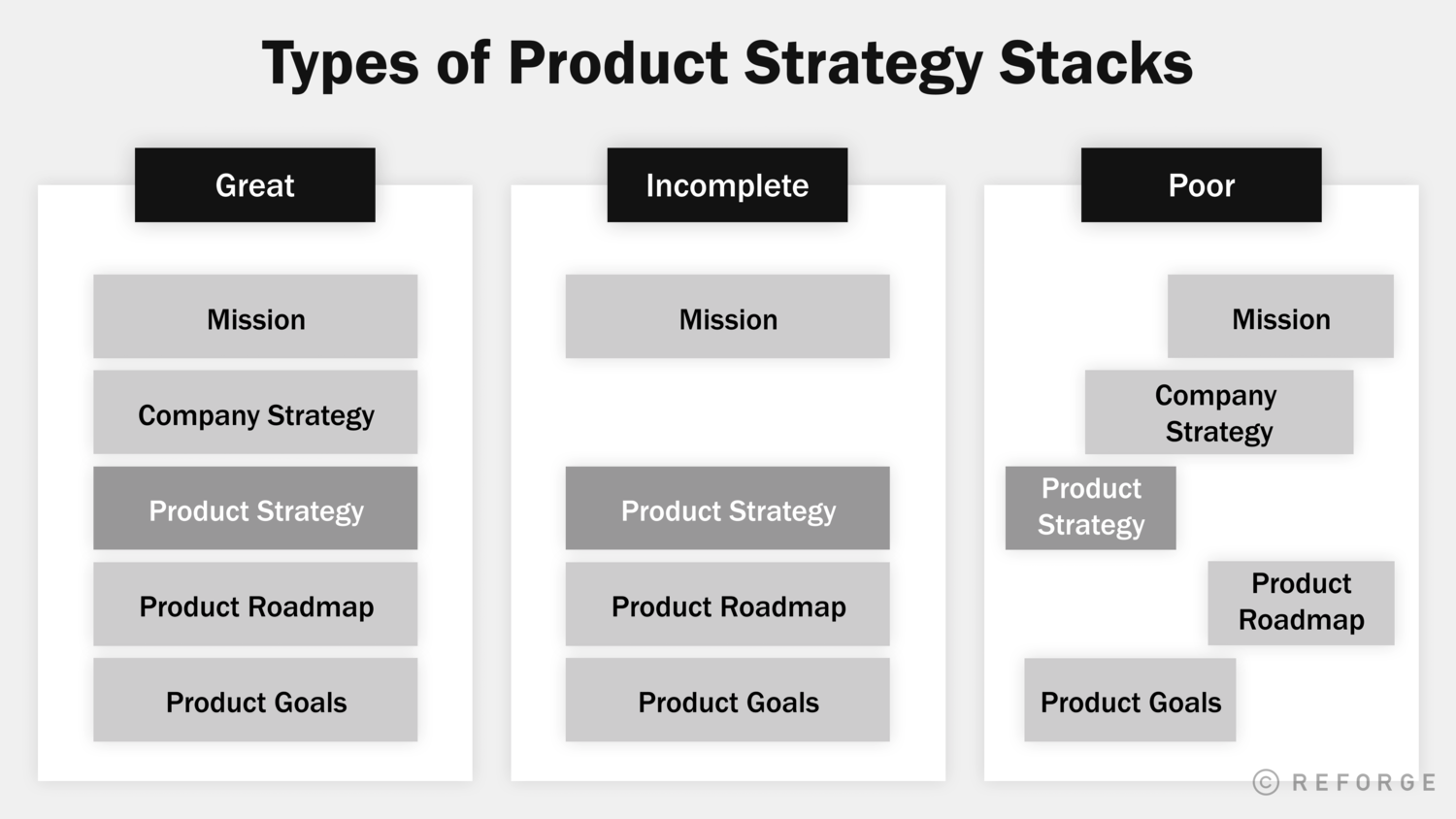
Clubhouse Case Study
The Product Strategy Stack can help us both define our own strategy and analyze the strategies of other companies. Let's apply the Product Strategy Stack to a recent success story to better understand how companies translate their strategy into product direction.
Clubhouse Company Mission
In less than a year, Clubhouse has grown from a small experiment in audio chat to a social network attracting millions of users, including well-known guests such as Elon Musk and Bill Gates. Clubhouse has described itself in a way that helps us understand its Company Mission:
Clubhouse was designed to be a space for authentic conversation and expression—where people can have fun, learn, make meaningful connections, and share rich experiences with others around the world.
Importantly, this statement makes no mention of "audio" as a defining trait of the company. "Conversation" is a central part of its mission, but we need to look further down the stack to understand how audio plays a role.
Clubhouse Company Strategy
The following helps us understand Clubhouse's Company Strategy:
Clubhouse is a new type of social network based on voice—where people around the world come together to talk, listen and learn from each other in real-time.
From this statement, we can reverse engineer the key points of Clubhouse's strategy:
- The company is creating a new type of social network to fill a whitespace that exists in the market.
- Voice is the central element of this new type of network. Earlier social networks capitalized on a defining feature of mobile—an integrated camera. Today, audio has become an increasingly important part of mobile, due to the ubiquity of Airpods and growing role of audio as an interface. The founders of Clubhouse explained their focus on voice: "Clubhouse is voice-only, and we think voice is a very special medium. With no camera on, you don’t have to worry about eye contact, what you’re wearing, or where you are."
- The company sees its users playing an active role, with equal opportunities to listen and talk*.* This blurring of the line between creator and audience is critical to Clubhouse's strategy.
- The company explicitly defines its audience as "people around the world," highlighting the global and inclusive nature of its community.
Clubhouse Product Strategy
This Company Strategy provides context for the app's Product Strategy:
When you open the app you can see “rooms” full of people talking—all open so you can hop in and out, exploring different conversations. You enter each room as an audience member, but if you want to talk you just raise your hand, and the speakers can choose to invite you up. Or you can create a room of your own. It’s a place to meet with friends and with new people around the world—to tell stories, ask questions, debate, learn, and have impromptu conversations on thousands of different topics.
Clubhouse Product Roadmap
Now, a product team can take this product strategy and define a clear roadmap. Some items could be:
- Identifying friends who are currently in a room to help people pick which room they want to join.
- Easily enabling a person to move between the audience and the stage.
- Robust profiles to help people get to know speakers and attendees.
- A way for people to identify their interests and explore rooms based on those interests.
- Tools to help moderators and speakers attract an audience.
We can see a progression from our aspirational mission to executable roadmap items, each of which reinforces the company's strategy.
Clubhouse Product Goals
Finally, we can define Product Goals that measure strategic progress. Some goals could be:
- Maintain an average speaker/attendee ratio of 1:10
- 50% of new members join a room with 1 or more existing connections
- 80% of daily active users have an opportunity to speak once a day
These goals measure how well the product helps people engage in authentic conversations and make meaningful connections—they are defined relative to the company's objectives, not in a vacuum.
Based on this analysis, we can see that Clubhouse has a complete, tightly aligned Product Strategy Stack. Each feature the company has implemented ladders up to a well-defined product and company strategy.
Should Clubhouse add audience interactions like reactions and chat?
Let's look at how we might use the Clubhouse Product Strategy Stack to make a prioritization decision. Many live experiences, such as Facebook Live and Twitch, give audiences the ability to interact with creators by sending text chat and reactions. Demand for this type of feature is already surfacing on Clubhouse—some participants have taken to rapidly flashing their "Mute" button to simulate clapping.
Clubhouse's Product Strategy Stack helps us ask the right questions:
- Will audience interactions lead to meaningful connections?
- How do audience interactions reinforce or hinder Clubhouse's voice-only product strategy?
- Will audience interactions help bridge the gap between creator and audience?
- Will audience interactions make Clubhouse more or less inclusive?
What do you think? Should Clubhouse add audience interactions? If so, what type of interactions make sense?
The Product Strategy Stack serves an important role—it doesn't provide the answer, but it does provide a framework that leads to an answer aligned with the company's mission and strategy. It helps us resist the temptation to reflexively respond as feature ideas come up, and encourages us to treat each feature as a stepping stone towards the future the company wants to build.

Stacks on Stacks
The Product Strategy Stack is just the beginning. Every function within a company must be aligned in order for a company to achieve its full potential. Technology, marketing, operations, and other functions need to define their functional strategies, roadmaps, and goals to ladder up to the company's strategy and help the company achieve its mission. We can see this level of alignment in a successful company such as Apple, where every element of the business reinforces a singular strategy and mission. Achieving this level of alignment isn't easy, but the strategy stack can help.
